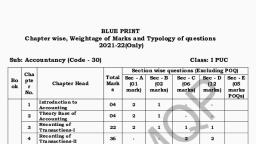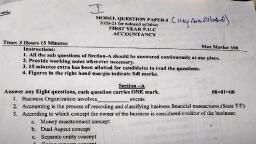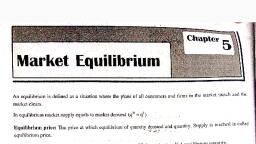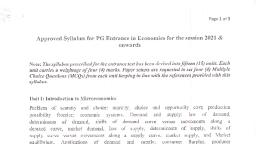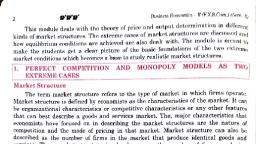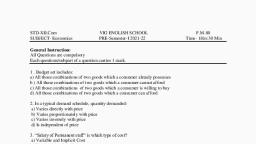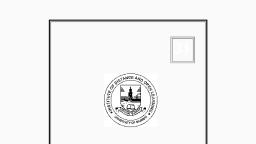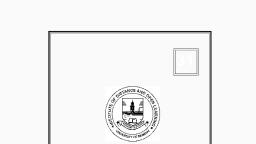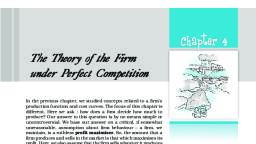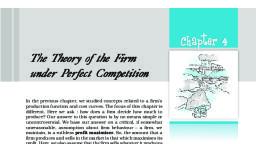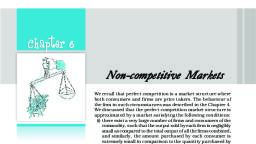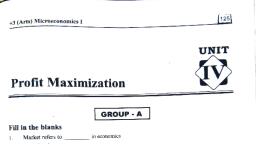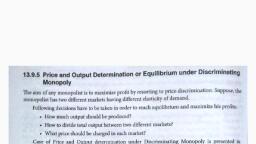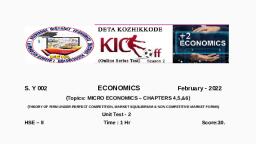Page 1 :
II PUC ECONOMICS CHAPTER 4 NOTES, Meaning of Market :, In Economics ‘Market’ refers to an arrangement where buyers, (consumers) and sellers (firms) come in contact with each other directly, or indirectly to buy or sell the goods., Perfect Competition, The market situation in which a large number of sellers compete to sell a, homogeneous commodity at a price set by the market is perfect, competition, Features of Perfect Competition:, (1) Large number of buyer and seller: The existence of large number, of buyer and seller means that each individual buyer and seller is very, small compared to the size of the market. Hence no individual buyer or, seller can influence the market price., (2) Homogeneous product: In the perfect competition market product, of each firm is identical. So the product of one firm cannot be, differentiated from the product of any other firm., (3) Free entry and exit: Under perfect competition market entry into, the market as well as exit from the market are free for firms. Hence the, number of firms are large in size., (4)Perfect market information: In perfect competition market as, product are homogeneous all buyer and all seller are completely, informed about the price, quality and other relevant details about the, product as well as market., (5) Price taking behavior: In perfect competition market all seller and, buyer are the price takers. A price taking firm believes that if it sets a, price above the market price. It will be unable to sell any quantity of the, good that it produces. On other hand price taking firm believes that if, she ask for a price below the market price no firm will be willing to sell, to her Hence both seller and buyers are the price takers., Revenue:
Page 2 :
Revenue refers to the money received by a firm from the sale of a given, quantity of a commodity in the market., There are mainly three concepts of revenue. They are, (a) Total Revenue, (b) Average Revenue, (c) Marginal Revenue, (a) Total Revenue: Total revenue is the total amount received by the, seller from the sale of a given amount of the product. If a firms’s output, is q and the market price is p, then TR equals pxq., Formula for calculating total revenue is, Total Revenue = Price × Quantity of output sold or, TR = P × Q, Total revenue curve:, , The total revenue curve for a firm in a perfectly competitive market is an, upward sloping curve because the price or AR remains constant and MR, is also equal to AR. Thus, TR can only be influenced by altering the, output sold, as the price remains constant. The increase in TR is in the, same proportion as the increase in the output sold., The curve passes through the origin, which implies that no matter what, the price level is, if the output sold is zero, TR will also be zero., (b) Average Revenue: The average revenue of a firm is defined as total, revenue per unit of output., Hence, Formula for calculating average revenue is AR = TR / Q, We know that, TR = P × Q
Page 3 :
AR = P, Thus, the market price and the average revenue are the same for a, perfect competitive firm., , In the above diagram on the OX axis we measure output and OY axis we, measure revenue/ market price. Since the market price is fixed at p, we, obtain a horizontal straight line that cuts the y-axis at a height equal to p., The horizontal line is called Price Line. It is also called the firm’s AR, curve under perfect competition., The price line also depicts the demand curve facing a firm. Observe that, the demand curve is perfectly elastic. This means that a firm can sell as, many units of the good as it wants to sell at price p., (c) Marginal Revenue: marginal revenue is the change in a firm’s total, revenue resulting from the sale of one extra unit., Marginal revenue is the revenue which is generated by selling an, additional unit of a commodity. It is the change in total revenue when an, additional unit of a commodity is sold in the market., MR = TRn – TRn-1, Or MR= ΔTR/ ΔQ
Page 4 :
For price taking firm, Marginal revenue equals to the Market price, MR=AR=P, Normal profit, A firm will be earning normal profits, if its revenue is sufficient to cover, all its costs. Normal profit is a situation where the revenue will be equal, to its costs., Normal Profit = TR – TC. It is a situation of Zero profit., Super Normal profit:, Profit that a firm earns over and above the normal profit is called the, super-normal profit., Shutdown point:, A firm continues to produce as long as the price remains greater than or, equal to the minimum of AVC. Below the minimum point of AVC there, will be no production, so the point where SMC curve cuts AVC curve at, the minimum is called the shut down point of the firm., Opportunity cost:, Opportunity cost of some activity is the gain foregone from the, second best activity. For example, if a person is having 2 acre of land he, can cultivate paddy or wheat. By cultivating paddy he earns ₹ 40,000. If, he cultivates wheat, he may earn ₹ 35,000. In the process of cultivating
Page 5 :
paddy, he has to sacrifice ₹ 35,000. So the opportunity cost of, cultivating paddy is ₹ 35, 000., Break Even Point:, The point on the supply curve at which a firm earns only normal profit is, called is called breakeven point of the firm. i. e a firm reaches its, breakeven point when its TR is equal to its TC., The point of minimum average cost at which the supply curve cuts the, LRAC curve in long run and SAC curve in the short run is therefore the, breakeven point of a firm., Profit maximization:, Profit (𝜋) is the difference between Total Revenue(TR) and Total Cost, (TC)of production., i.e. 𝜋= TR-TC, For profits to be maximum, three conditions must hold at q 0, (a) The price, p, must be equal to MC. Or P = MC, (b) MC must be non-decreasing at q0., (c) For the firm to continue to produce, in the short run, price must be, greater than the average variable cost [p>AVC); in the long run, price, must be greater than the average cost [p>AC]., (a) When P = MC, As long as MR is greater than MC, profits are increasing. As long as, marginal revenue is less than marginal cost, profits will fall. It follows, that for profits to be maximum, marginal revenue should equal marginal, cost. Profits are maximum at the level of output (which we have called, q0) for which MR = MC, For the perfectly competitive firm, we have established that, MR = p., So the firm’s profit maximizing output becomes the level of output at, which P = MC.
Page 6 :
(b) MC must be non-decreasing at q0. ( at equilibrium output), , Note that at output level q1 and q4, the market price is equal to the, marginal cost. However, at output level q1, the MC curve is downward, sloping hence q1 cannot be a profit maximizing output level. As P is the, market price in the output level q2 and q3 market price is exceeds, Marginal Cost (P>MC) and in the output level q5 and q6 Marginal Cost, exceeds market price (MC>P) i.e. Price is less than the Marginal Cost., Hence output level q4 fulfill the second condition.

